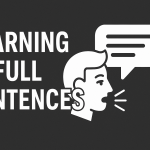Mnemonics is a type of mental technique that aids organization and memorization and facilitates the acquisition of more information. In the context of language learning, mnemonics can speed up the process of mastering the desired language, enabling more effective memorization of words and language structures.
These primarily include visualization techniques. Mnemonic techniques are considered so effective that Anthony Metivier, a world-renowned memorization expert, strongly advocates their use.
Effective learning is all about remembering information permanently and in such a way that it can be recalled effectively when needed. For this to be possible, both hemispheres of the brain must be activated. The general rule is that the right side is responsible for creativity and imagination, while the left side is responsible for logical thinking and understanding words. Memorization methods based on mnemonics work in such a way that both hemispheres are activated at the same time, so you are able to process and remember data in a more efficient and lasting way.
Memory Palace – the origins of mnemonics
The subject of memory has fascinated people since the dawn of time. The ancient poet Simonides of Keos is considered the “discoverer” of mnemonics. However, the story is quite tragic – the roof of a house collapsed during a party. Many people tragically died, and their mangled bodies were difficult to identify. However, Symonides helped identify them, as he remembered where each person was sitting.
It is from this event that the name of the memory palace (“method of loci”, Roman room) is derived. The idea is to locate the information you want to remember in a familiar space (context), in specific places that are familiar to you.
This technique requires the creation of a real or imaginary room or building type structure. For example, if you are able to imagine your bedroom, you can create a kind of memory palace. Once you have determined where you want to build your mental palace, you determine and memorize the order of places in the room. By establishing the order going clockwise, for example: 1st dresser, 2nd bed ,3rd carpet, 4th boss, etc. you will be able to use this order wherever you need the sequence. Now on each of these places you place imaginary scenes that represent what you want to remember. Interestingly enough, you only need to associate these scenes loosely with the information you are remembering.
For example, we have a few sentences to remember and one of them is the Spanish question, Como se llama? (“What is your name?”). So we place on the dresser a strange gentleman in a colorful sombrero who is holding a large bundle of comos (Como se) which he is plucking from a llama (llama), who by the way indignantly asks him: What is your name? You’ll admit that it’s quite a surreal sight in your bedroom. And that’s exactly the point. It turns out that it’s quite easy for us to remember these kinds of stories. Importantly, these associations don’t always have to sound exactly like the sentence in the target language. In the case of the llama sentence, we got a sound very similar to Spanish, but often a single sound or word is enough to create an effective association.
Another example is the Italian word “la piazza”. If you’re learning Italian, envision a picturesque piazza hanging above your bedside table titled “La piazza” (Italian for “the square”). The Italian word “piazza” sounds similar to the English word “pizza.” Visualize a bustling piazza with people enjoying slices of pizza at outdoor cafes, linking the two words in your mind. This imaginative scene will reinforce the association between “piazza” and its meaning.
Spaced Repetition
If you don’t repeat information, it probably won’t be stored in your long-term memory. Regular repetition of information to reinforce its storage in the memory is a key part of learning any subject, especially a foreign language. Repetition is the key to long-term memorization. If you repeat given vocabulary words or whole sentences at appropriate intervals, they will go into your long-term memory, and you will be able to recall them at any time.
Unfortunately, not every type of repetition is equally effective. When learning a foreign language, the most important thing is that the repetition is sufficiently difficult and takes place at specific intervals. Such a method is called spaced repetition. Simplifying, the material that gives you the most difficulty should be repeated much more often than ones you have less trouble with. The more familiar you are with the material, the less frequently it will appear on repetition, until it is finally stored effectively in your long-term memory.
Learn more about this topic by reading our article on Spaced Repetition, the method used by the Taalhammer app.
Storytelling
Creating stories that contain information you want to remember. The more interesting or entertaining the story is, the easier you will remember it. Using stories, histories, or fairy tales can be a great way to learn a foreign language. Olly Richards, a teacher and language learner, has even created a method they call StoryLearning to learn language from stories. It is indeed an effective method, but it should be combined with others to get the most out of it.
What’s more, it’s good to know that you learn best from stories you are already familiar with. There are studies that indicate that you are able to understand much more from stories you already know in your native language, even if they are told in a foreign language. Studies have indicated that when beginners in a language read books they previously knew, such as The Little Prince, Sleeping Beauty, Cinderella, etc., they were able to understand up to 20% of the vocabulary. A study in which beginners listened to current news in a foreign language had a similar effect.
You can learn more by reading our articles about how to use storytelling in language learning.
Nursery rhymes and songs
Turning information into rhymes or songs makes them easier to remember. Surely you remember the song “Old McDonald” or other rhymes from your English lessons? If not, you can always create them or reach for those available from various sources and repeat them. Although they sound ridiculous, it’s easy to remember information with them. This is because you learn by heart whole texts that make sense. This method is much more effective than recalling single vocabulary words.
Learn more about using songs for language learning, where we show you, using a beautiful Dutch ballad as an example, how to effectively use your favorite songs to learn the language.
In Taalhammer we offer you a language radio, where you can practice listening in a variety of exercises. This trains your ear, helps you understand spoken language and improves your accent in a foreign language.







